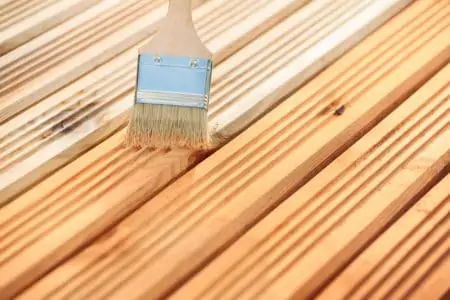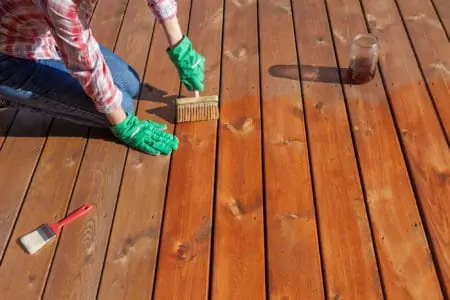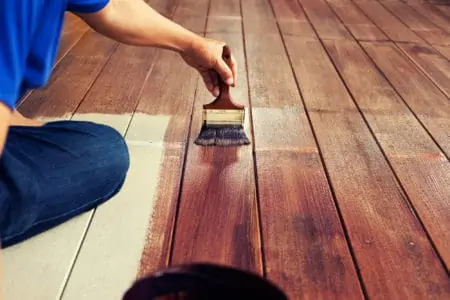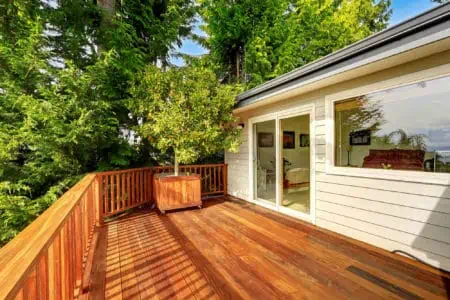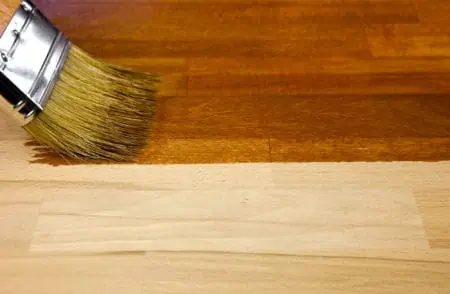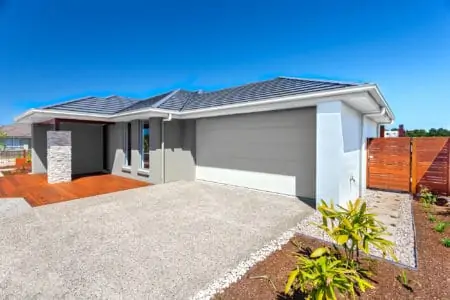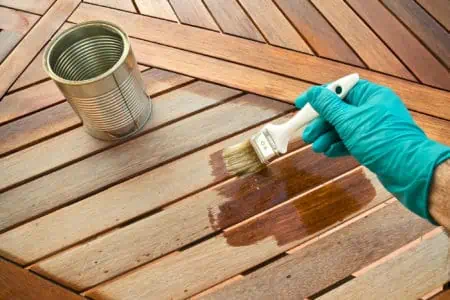Pressure-treated wood is ideal for making garden decks because it is already treated to withstand the elements. However, even pressure-treated wood suffers from the effects of the sun and rain. Sometimes, it needs a helping hand.
We rate the best deck stains for pressure-treated wood, considering their type, ease of application, and value for money.
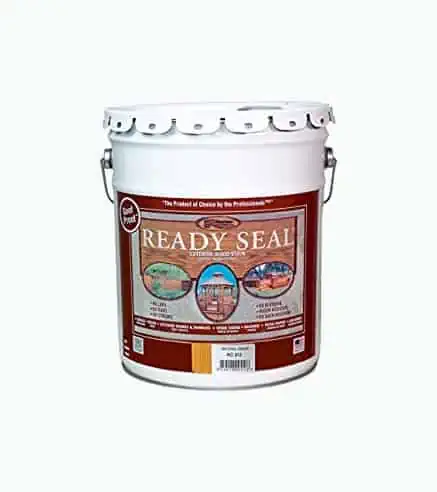
- No wet-line application & self-blending
- Requires no primer, saving time
- Can be recoated in just 45 minutes
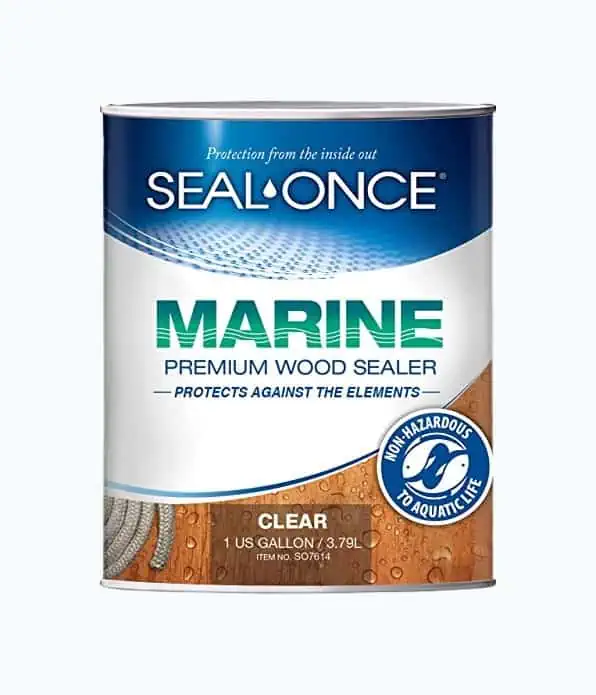
- Penetrates & seals against UV and moisture
- Safe for people, pets, and the environment
- Repels saltwater and extreme weather
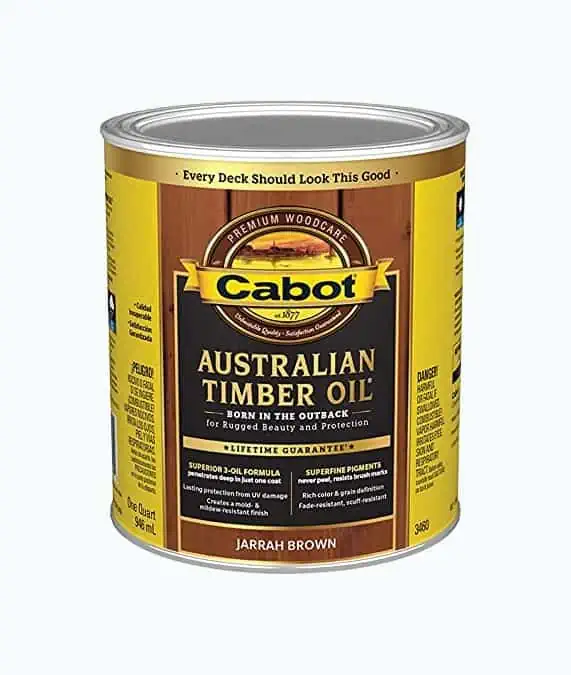
- Great for enhancing exotic woods
- Covers 250 – 600 sqft per gal.
- Deflects UV & absorbs heat through iron-oxide pigments
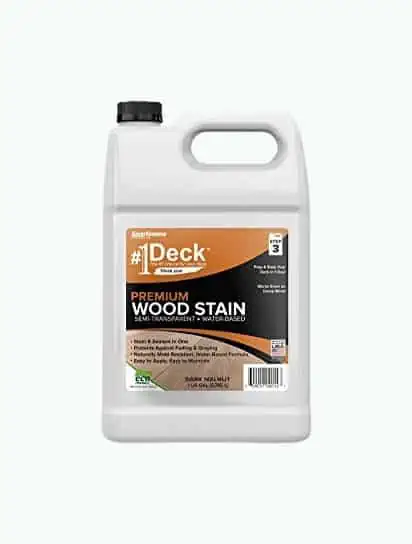
- Suitable for most wood types
- Comes in 5 vibrant colors
- Ultra-low VOCs at 50 grams per liter
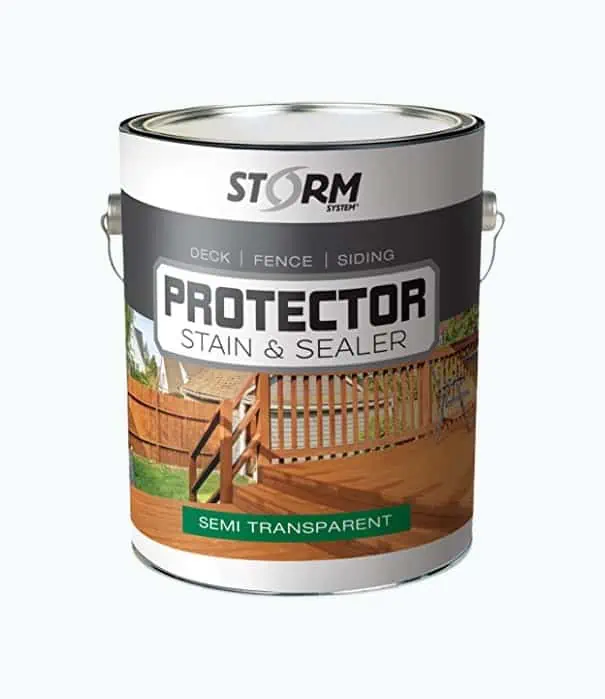
- UV protection and lap-free application
- Various color options to choose from
- Works on most wood
Review Methodology: At Sensible Digs, we understand how crucial it is to find the best deck stains for pressure treated wood. Our professional team conducts thorough research, carefully comparing products, and analyzing their performance based on several criteria. We assess each stain’s durability, color retention, ease of application, and overall value. Our hands-on experience with these products, combined with our detailed data analysis, allows us to provide an unbiased review that evaluates each product from a user’s perspective. We also delve into the design choices of each product and their effect on users, as well as identifying what sets each product apart from its competitors. Our findings are always based on facts and evidence, ensuring you have the most comprehensive and reliable information to make your deck stain decision.
The Best Deck Stains for Pressure-Treated Wood of 2024
With so many deck stains to choose from, we conducted hours of research, rating each product on coverage, value for money, and ease of application.
Ready Seal 5-Gallon Natural Cedar Exterior Wood Stain
Best Deck Stain for Old Pressure Treated Wood
If you have an extensive deck, this 5-gallon tub of wood stain will last the distance. It requires no primer and can be painted straight onto a bare deck. You can apply it with a brush, roller, or sprayer, and for re-application, you don’t need to sand or strip the old wood.
This is a cedar-colored wood stain, but you need to wait 14 days for the color to emerge fully, and it requires no back brushing. It will also never run, streak, or lap, and you get between 125 and 185 square feet of coverage per gallon.
This product has no wet-line application, and it self-blends to leave zero lines. It comes in 9 color choices, so you can match it to your color scheme. The only downside with this stain is you cannot apply it to previously painted decks or newly treated wood, so make sure you allow the deck to dry.
Once down, it takes 45 minutes to dry to the touch and for recoats, but you should wait 48 to 72 hours for the stain to cure before using the deck. Also, because this is an oil-based product, it is damaging to the environment, so its use needs to be controlled, and you cannot buy this stain in California.
Pros
- No wet-line application and self-blending.
- Requires no primer, saving time.
- Can be recoated in just 45 minutes.
- Comes in 5-gallon containers for extensive decks.
Cons
- Cannot be applied to painted or newly treated wood.
- Oil-based, so damaging to the environment.
- Not available in California.
Product Specs
| Quantity | 5 gallons |
| Coverage | 125 to 185 square feet per gallon |
| Drying time | 48 to 72 hours |
| Type | Oil |
| Price | $$$ |
Our Ratings
User Experience
Seal-Once Marine Penetrating Sealer and Stain
Best Marine-Grade Stain for Pressure Treated Wood
When you need superior water protection, you can’t get much better than this marine-grade deck stain. If it repels saltwater and everything the ocean can throw at it, it will protect your deck from the elements.
This is a water-based formula, so it is kind to the environment and washes clean with soap and water. It produces low odors and virtually no VOCs. In addition, it is safe for pets, people, plants, and marine life.
This water-based stain uses nanotechnology to penetrate deep into the wood to give superior protection. At the same time, the topcoat dries to form a hard barrier against the damaging UV rays and moisture.
The only cloud in the sky is the price. This is almost half the price of the previous stain, but that was a 5-gallon container. This one is just 1-gallon! However, you get 250 to 350 square feet of coverage per gallon, depending on the porosity of the surface. It also dries in 24 hours.
Pros
- Penetrates and seals against UV and moisture.
- Safe for people, pets, and the environment.
- Repels saltwater and extreme weather.
- Covers 250 to 350 square feet.
Cons
- Cost per gallon is expensive.
Product Specs
| Quantity | 1-gallon |
| Coverage | 250 to 350 square feet per gallon |
| Drying time | 24 hours |
| Type | Water |
| Price | $$$$$ |
Our Ratings
Personal Perspective
Cabot Australian Timber Oil
Best Oil-Based Stain for Pressure-Treated Wood
This Australian oil-based deck stain is ideal for exotic woods, as well as teak and mahogany. It’s also great for coverage, spreading 400 to 600 square feet for smooth surfaces and 250 to 350 square feet for porous surfaces.
It contains iron-oxide pigments to enhance the color and deflect the heat from the sun’s rays to reduce fading, splitting, and drying of the wood. This stain penetrates deep into the wood to enhance the color and the grain.
This product comes in 1-quart tins and 10 different colors to match your garden scheme. It takes approximately 24 to 48 hours to cure, and when dry, forms a flat, translucent finish.
This is an oil-based stain, so it releases VOCs as it dries, which are dangerous if inhaled. Plus, oil products are damaging to the environment. It is also highly flammable, so you should discard any rags and sponges in a metal container to reduce the risk of fire.
Pros
- Great for enhancing exotic woods.
- Covers 250 to 600 square feet per gallon.
- Deflects UV and absorbs heat through iron-oxide pigments.
- Penetrates deep into the wood.
Cons
- Bad for the environment and high VOCs.
- Highly flammable, so take care discarding rags and sponges.
Product Specs
| Quantity | 1-quart |
| Coverage | 250 to 600 square feet per gallon |
| Drying time | 24 to 48 hours |
| Type | Oil |
| Price | $$$ |
Our Ratings
Community Feedback
#1 Deck Premium Semi-Transparent Wood Stain
Best Water-Based Stain for Pressure Treated Wood
This stain can be used on pressure-treated pine, cedar, fir, redwood, and most other wood types. This is a stain and deck sealer in one, and the company claims you can complete your deck in a single day.
It comes in 5 vibrant colors and is ultra-low VOC, at just 50 grams per liter, and because it’s water-based, it is kind to the environment and washes clean with water and soap.
You can even use this stain on damp wood, so if you are coating newly treated decking, you don’t have to wait for it to dry. It is ready for recoats in about an hour, and it protects against fading and graying.
The coverage is not as impressive as other products. This 1-gallon can spreads over 100 square feet, which is way down on similar stains.
Pros
- Suitable for most wood types.
- Comes in 5 vibrant colors.
- Ultra-low VOCs at 50 grams per liter.
- Adheres to damp and newly treated wood.
Cons
- Only gives 100 square feet of coverage.
Product Specs
| Quantity | 1-gallon |
| Coverage | 100 square feet per gallon |
| Drying time | 1 hour |
| Type | Water |
| Price | $$ |
Our Ratings
First-Hand Impression
Storm System Semi-Transparent Wood Sealer & Stain
Best Semi-Transparent Deck Stain for Pressure-Treated Wood
This Storm System wood stain is an oil-based product. What’s more, this stain protects your deck from UV. It also makes an easy, lap-free application ensuring a great outcome from painting.
An entire gallon covers up to 175 square feet for smooth surfaces while 150 square feet for porous surfaces. For the best results, you should sand the deck, wash it down and then wait 24 hours before you apply the stain.
Pros
- UV protection and lap-free application.
- Works in most woods.
- Oil-based stain.
- 2-in-1 product.
- Various color options to choose from.
Cons
- Not great for old and faded wood.
Product Specs
| Quantity | 1-gallon |
| Coverage | 150 to 175 square feet per gallon |
| Drying time | 36 hours |
| Type | Oil |
| Price | $$ |
Our Ratings
User Experience
| Product | Best | Quantity | Coverage | Drying time | Type | Price |
|---|---|---|---|---|---|---|
| Ready Seal 5-Gallon Natural Cedar Exterior Wood Stain | Best for Old Pressure Treated Wood | 5 gal. | 125 – 185 sqft per gal. | 48 – 72 hours | Oil | $$$ |
| Seal-Once Marine Penetrating Sealer and Stain | Best Marine-Grade | 1-gal. | 250 – 350 sqft per gal. | 24 hours | Water | $$$$$ |
| Cabot Australian Timber Oil | Best Oil-Based | 1-quart | 250 – 600 sqft per gal. | 24 – 48 hours | Oil | $$$ |
| #1 Deck Premium Semi-Transparent Wood Stain | Best Water-Based | 1-gal. | 100 sqft per gal. | 1 hour | Water | $$ |
| Storm System Semi-Transparent | Best Semi-Transparent | 1-gal. | 150 – 175 sqft per gal. | 36 hours | Oil | $$ |
Water-Based vs Oil-Based Deck Stains
While water or oil-based stains essentially do the same thing, they are both very different in their application, preserving qualities, and overall finish. Let’s take a look.
Water-Based
Water-based stains are easier to apply because they are thinner. It means you can brush, roll and spray them onto the surface of your deck. This type of stain works to protect the wood by drying to form a hard seal on the surface of the lumber.
This protective layer prevents rain and UV rays from penetrating the wood beneath, keeping it from drying out, cracking, and fading. However, pressure-treated wood is impregnated with preserving agents, so you might find that the water-based solutions fail to bond properly.
In addition, water-based stains chip, scuff, and flake more easily than oil versions. For this reason, you might find yourself recoating your deck every other year. Plus, garden decks are high-traffic areas with furniture and footfall, so that new topcoat will soon wear away.
However, water-based stains are better for the environment, thanks to their formula, so it doesn’t pollute the environment when it washes away. And if you are in a hurry, this type of stain is ideal because it dries in super-quick time.
Oil-Based
Oil-based stains are better for penetrating deep into the wood, which is better if you want to preserve the natural grain of the deck. They work differently from water-based options because they protect from within the wood, forming a protective layer deep inside the deck.
For this reason, they offer long-lasting qualities repelling the sun’s rays and extreme weather. However, most oil-based stains are thicker in viscosity, which means applying them is more challenging.
You can brush and roll it on, but if your preferred option is to spray, you may need a thinning agent to dilute the formula. And oil stains have a slightly golden hue, so when it dries, you are left with a richer color rather than the natural shade of the wood grain.
There’s also the question of the environment. Oil is a pollutant, so as it washes away, it drains into the ecosystem, polluting streams and rivers. A well-applied oil stain should give you 2 or 3 years of protection.
| Water-based | Oil-based | |
| Pros |
|
|
| Cons |
|
|
How To Choose the Best Deck Stains for Pressure-Treated Wood
Deciding which deck stain is best for you is one thing, but how do you choose, and what factors should you keep an eye out for?
Here are some pointers to help you decide.
